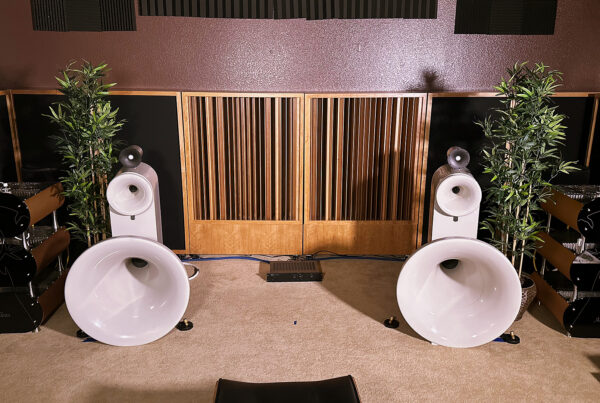Temu Music
Studio
Upgrade
Temu built our DIY / BDA units using our build drawings. Budget allowed for the building of the cabinet but did not allow for our carbon technology inside the units. Our carbon technology increases the performance of each unit by 40%. Temu built the units with a removable top piece so that as the budget grew he could use our carbon technology at a later date. All of the data shown is based upon 8 units of coverage and only on the front wall.
The two main issues one has in any small room. We have pressure and reflections. Pressure is created by frequencies below 100 hz. Frequencies above 100 hz. are mainly reflection oriented. A 40 hz. wavelength is 28′ long. In most rooms, this wavelength will not fit into existing room dimensions.
When the energy created by a source will not fit, it causes the air between the sidewalls, front to rear, and floor to ceiling to vibrate. This vibration creates what we term room modes. Room modes can exaggerate certain frequencies and completely minimize others to the point you can not hear them.
Room modes are the peaks and dips shown on the frequency response curves. They are between the sidewalls, front to rear walls, and the floor to ceiling surface areas. In any critical design work, you must first define the frequency of the modal issue along with the amplitude (strength) of that issue. The strength can be a peak or a dip. Peaks are usually greater than dips in amplitude or strength.
For purposes in this phase of his project, Temu focused only on the front wall which is the area behind the speakers. He will build more units for the sidewall to sidewall issues along with the floor to ceiling.



Effective Room Treatment: Linearity and Consistency
With treatment types, you must have two main ingredients. The treatments must be predictable and consistent in performance. They must be linear in their response to a wide range of frequencies. A low frequency absorption technology must have the level of reach to get down into the 30 hz. regions.
Notice the rates and levels of our Activated Carbon Diaphragmatic Absorber (ACDA) series in the graphic. It must also have the horsepower to absorb a lot of that excess energy. Notice the impact just treating one wall had on the response curves below 100 hz. There must be a combination of linearity and consistency in order to smooth out the peaks and dips along with enough surface area coverage.
Most energy that is inserted into a small box (room), overstays its welcome. Low frequency pressure produces room modes. Middle and high frequency reflections produce reverberation. Room design is a tug of war with both pressure and reflection issues. The decay rates in any room must be smooth and linear, just like the treatment that is used to manage it. Decay is where our harmonics live.
The first, second, and third order harmonics are to be found in the decay of the fundamentals. The room must allow the energies of music to live and die on their own volition. The room must get out of the way of both our voice and music. Stay tuned for part three in this series where Temu treats the remaining surface areas and watch how all the numbers come together.
Before & After








Do you want to solve your room acoustic problems?
There’s no one size fits all when it comes to room acoustics.
Get your FREE personal room acoustics analysis by chief acoustics engineer Dennis Foley.








